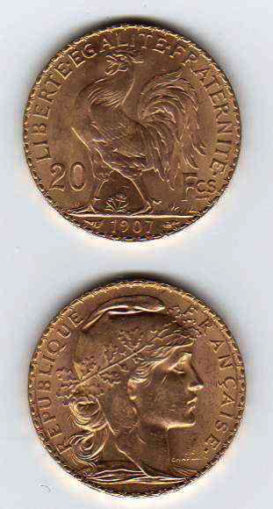I had vaguely heard of the Latin Monetary Union and decided to do some research for this article after viewing some gold coins from this period on an auction website.
The Latin Monetary Union (LMU) was a more informal and less centralised predecessor of the current European Union. Unlike the EU, the LMU was founded on honest money.
The LMU was established in a treaty between France, Belgium, Switzerland and Italy (including the Papal States) in 1865. The aim of the LMU was to enhance trade between the various countries by standardising the weight and dimensions of their coinage. It came into effect on 1st August 1866, and ended in 1927.
The treaty was possible because at this time the signatories, as well many other nations, used a bi-metallic standard where gold and silver coins were equal in value as a currency to their value as a precious metal. Coins were literally worth their weight in, and were exchangeable for, gold and silver.
The LMU adopted the specifications of the French gold franc, which had been introduced by Napoleon I in 1803 and was struck in denominations of 5, 10, 20, 40, 50 and 100 francs, with the 20 franc coin being the most common. In the French system the gold franc was interchangeable with the silver franc based on an exchange ratio of 1 to 15.5, which was the approximate relative value of the two metals at that time.

Pièce 20 Francs Français en Or,
Jules-Clément Chaplain – Public domain
The idea behind this was that, as gold and silver had the same value in any country, the standardised coins became more easily interchangeable. In this manner a French trader could accept Italian lire for his goods with confidence that it could be converted back to a comparable amount of francs. Removing the need to weigh a coin, and verify its purity, would significantly speed up the process for traders in each country.
Many French colonies joined or followed the LMU standards. Greece formally joined the Union in 1867 and conformed its currency to the group’s regulations.
Spain, Romania, Bulgaria, Finland, Serbia, as well as Latin American countries such as Peru, Colombia and Venezuela, adopted the Union’s standard but remained outside of the Union officially. Austria-Hungary also remained outside the Union but entered into a separate currency agreement with France.
Despite its apparent success, the LMU was deeply flawed and several critical mistakes were made in its set up and development. Key downfalls were the abuse and the breaches of the treaty. In 1866, Giacomo Antonelli, the administrator of the Papal Treasury embarked on an ambitious increase in silver coinage to the equivalent of Belgium’s total. The papal coins quickly became debased and excessively circulated in other union states, to the profit of the Holy See, but Swiss and French banks rejected papal coins (despite Napoleon III’s tacit agreement with Giacomo Antonelli) and the Papal States were ejected from the Union in 1870, owing 20 million lire (the equivalent of 83 million Euro today).
Problems with the economy meant successive Greek governments responded by decreasing the amount of gold in their coins, thereby debasing their currency in relation to those of other nations in the LMU and in direct violation of the original agreement. Greece was formally expelled from the LMU in 1908, although it was readmitted in 1910.
France and Italy, too, abused the LMU by printing paper money based on the bi-metallic currency, which was technically outlawed. The two countries printed an extensive amount of money to finance their projects, while other Union members had to bear the costs.
Another critical problem, perhaps the main one, was that bimetallism is subject to fluctuation in the value of the two metals used, gold and silver. New silver extraction and refining techniques, a huge increase in silver imports by France and Belgium, and a natural decrease in silver value led to huge stress on the Union’s economy. The exchange rate of 1 to 15.5 was no longer the reflection of the real value.
The Germans used this to their advantage, exchanging overvalued silver coins for gold coins that they would insert in their own monetary union, the Zollverein. In response to this, the mintage of silver coins was entirely suspended in 1878. From this date to the end, the LMU became de facto gold standard only. Payment in silver was still allowed, but customs were only in gold.
The LMU legally came to an end in 1927 as a result of economic crises caused by the First World War. which led to the suspension of the Gold Standard throughout the international monetary system.
Despite the LMU coming to an end, coins to LMU standards were still minted by the Swiss until 1967. Austria still mints gold 4 and 8 florin coins to LMU standards for collectors and investors.
It’s interesting to see parallels of the LMU with the EU. The Italians ignoring the rules, Greece having financial ‘difficulties’, members of the LMU printing their own money to finance their ‘projects’ at the cost of other member and the Germans wanting to be ‘top dog’ in Europe. Seems some things never change.
The Goodnight Vienna Audio file



